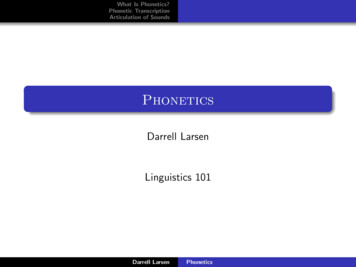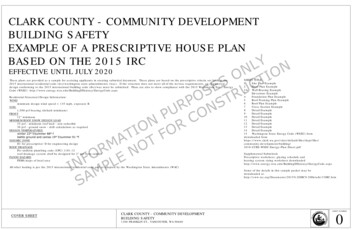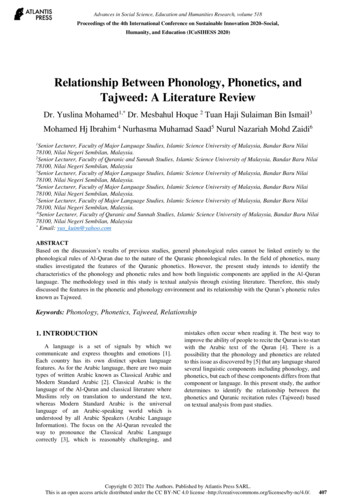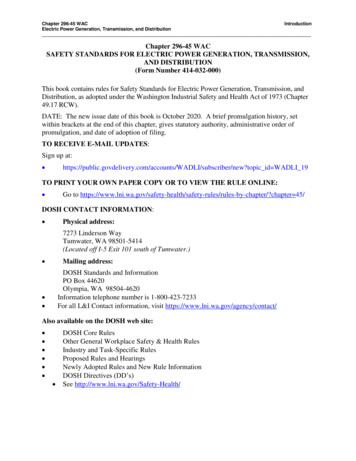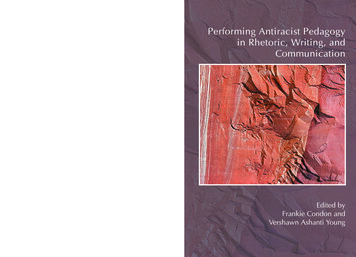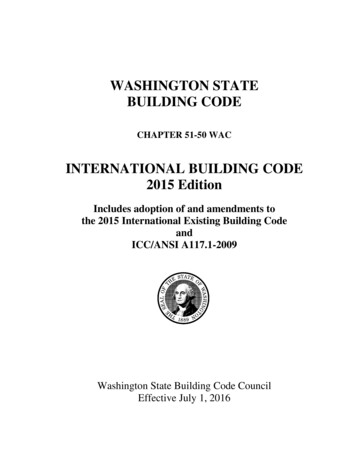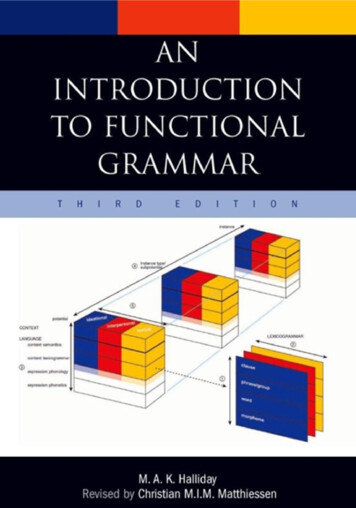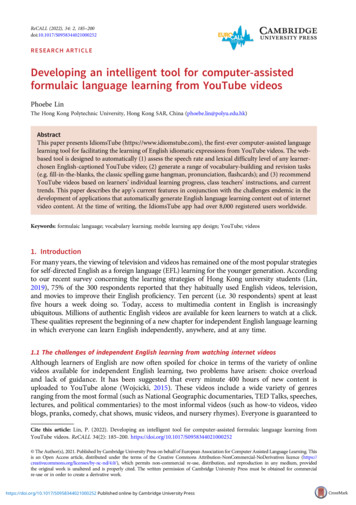
Transcription
4 Phonetics and Phonologykey conceptsArticulatory phonetics, phonetic symbolsConsonants, approximants, vowelsSyllables, feetPhonology, phonemes, allophones, phonological rulesi n t ro d u c t i o nIn this chapter we sketch the pronunciation system of English. We beginwith phonetics, a system for describing and recording the sounds of language objectively. Phonetics provides a valuable way of opening our ears tofacets of language that we tend to understand by reference to their writtenrather than their actual spoken forms. Phonology concerns itself with theways in which languages make use of sounds to distinguish words from eachother.Teachers should be knowledgeable about the phonetics and phonologyof English because (1) the sound system is primary and the basis for thespelling system; (2) they may have to teach English pronunciation to students who are not native speakers of English; (3) they may have to teachpoetry, which requires that they teach about rhyme, alliteration, assonance,and other poetic devices that manipulate sound; (4) it is important to understand accents and language variation and to react appropriately to themand to teach appropriate language attitudes about them to students (see ourchapters on Language and Society and Usage in Book II); (5) we are so literate that we tend to “hear” the sounds of our language through its spellingsystem, and phonetics/phonology provides a corrective to that; and (6) phonetics and phonology provide systematic and well-founded understandingsof the sound patterns of English.a rt i c u l ato ry p h o n e t i c sWe have three goals in this section. First, we introduce you to the ways inwhich the sounds of English are produced. Second, we develop a system forclassifying speech sounds on the basis of how they are produced. Simultaneously we introduce an alphabet approximating that developed by the International Phonetics Association (IPA), which will allow us to refer to soundsquite precisely. When we want to indicate that letters are to be interpretedas phonetic symbols, we enclose them in square brackets, [ ], and when wewant to indicate that letters are to be interpreted as letters from an ordinaryspelling system, we enclose them in angled brackets, .89
Delahunty and GarveyThe phonetic alphabet uses many of the letters of the English alphabet, buttheir pronunciations are very restricted and are not always the ones you mightexpect. In this system, there are no “silent” letters—every phonetic symbolrepresents an actual sound. Every letter always has the same pronunciationregardless of its context, no letter has more than one pronunciation, and nosounds are represented by more than one letter. To make fine distinctions,phoneticians add special symbols, called diacritics, to the basic letters. Forsome English sounds and for languages other than English, symbols not fromthe English alphabet have been devised. (You might visit the IPA web site fora full listing of the symbols.)In the sections to follow, we describe the sounds represented by thesesymbols and how these sounds are made. As we go through these sections,pay attention to the ways in which individual sounds are ordinarily spelledin English, as well as to the phonetic spellings.To produce speech, air must flow from the lungs through the vocal tract,which includes the vocal folds (popularly called the vocal cords, thoughthey are more like thick elastic bands than strings), the nose or nasal cavity, and the mouth or oral cavity (See Figure 1). The vocal folds vibratefor some sounds but not for others. Air flows through the nose for certainsounds but not others. But the main creator of speech sounds is the mouth.We will describe the roles that each of these elements plays in the followingparagraphs.figure 1: vocal apparatus90
Phonetics and Phonolog yco n s o n a n tsConsonants include the sounds we represent as p, b, t, d, m, n, f, v, s, z,l, r, h in the ordinary alphabet. All consonants are produced by entirelyor almost entirely stopping the airstream coming from the lungs. Whenwe almost entirely stop the airstream we force it through such a narrowopening that the airflow at that point is turbulent and noisy.We classify consonants according to the following characteristics: (a)whether or not the vocal folds are vibrating (voicing); (b) whether thesound is made with a fully stopped or merely constricted airstream (its manner of articulation); (c) where in the mouth the stoppage or constriction ismade (its place of articulation); (d) whether or not air is flowing throughthe nasal cavity (nasality); and (e) whether or not the lips are pursed (liprounding).VoicingAs a warm-up exercise, make the sound fffff, and keep it going for a count offive. Now make the sound vvvvv, and keep it going for a count of five. Nowalternate these two: fffffvvvvvfffffvvvvv. You probably noticed that vvvvvhad a “buzz” that fffff did not have. That “buzz” is caused by the vibratingof your vocal folds—which you can check by putting your fingers on yourthroat or by covering your ears as you alternate fffff and vvvvv. Now try thesame exercises with the first sounds of the following words: thigh, thy; sip,zip. You should be able to feel the vocal folds vibrate as you make the secondsound of each pair.Sounds produced with vibrating vocal folds (see Figure 1) are said to bevoiced; those produced without vocal cord vibration are voiceless. Table 1lists the voiced and voiceless consonants of English. The letters in [ ] are thephonetic symbols for the sounds.voiced voicelessby [b] pie [p]my [m]wet [w]vie [v]fie [f]thy [ ] thigh [T]die [d] tie [t]nigh [n]zip [z] sip [s]lie [l]rye [r]91
Delahunty and Garveybeige [Z] bash [S]jive [dZ] chive [tS]yet [j]guide [g] kite [k]gong [N]hive [h]table 1: voiced and voiceless consonantsExercise1. Collect a set of words in which each of the voiced and voicelesssounds listed in the two columns above occurs as the first sound of aword, in the middle of a word (specifically between two vowels), and atthe end of a word, as in: [b] bird, rubbing, rub; [p] pan, tapping, tap.How are each of these sounds ordinarily spelled? (Note: English singleand double consonants, as in rub and rubbing, tap and tapping, represent the same sound. The doubled consonants tell us how the vowelbefore them is to be pronounced; cf. tapping, taping.)2. Identify the sound represented by each of the following phoneticsymbols and for each sound collect five words in which it occurs: [p,b, f, v, T, D, S, Z, tS, dZ, s, z]. How is each of these sounds ordinarilyspelled?NasalityMake the sound represented by m in the word Pam and continue itfor some seconds. As you continue it, pinch your nose and observe whathappens to the sound. It should stop immediately. This shows that air wasflowing through your nose as you produced this sound. Now try the samelittle experiment with the n of pan and the ng of pang. You should findthat the air flows through the nose in these two cases also. Sounds in whichair flows through the nose are called nasal sounds. The air is allowed intothe nose by lowering the velum, the soft palate at the back of the mouth (seeFigure 1). English has three main nasal sounds:[m] Pam[n] pan[N] pang92clammyclannishclingymatNat----
Phonetics and Phonolog yExerciseUsing the data just above, say where [N] cannot occur in a word. Howare each of these nasal sounds ordinarily spelled?Manner of articulationBy manner of articulation we mean the kind of closure or constrictionused in making the sound. We classify English consonants according tothree manners of articulation: stops (full stoppage of the airstream somewhere in the oral cavity between the vocal folds and the lips, as in [p], [b],[m]); fricatives (constriction of the airstream in the oral cavity producing turbulence and noise, as in [f], [v]); affricates (full stoppage of theairstream followed immediately by constriction, as in [tS], [dZ]). Table 2summarizes the different manners of articulation.Stops[p] pad[t] tad[k] cadFricatives[f] fie[T] thigh[s] Sue[S] shoe[h] how[b][d][g]baddadgad[v][D][z][Z]viethyzoojus (au jus)[m][n][N]matNattangAffricates[tS] chin[dZ] gintable 2: manners of articulationExerciseFor each of the sounds listed in Table 2, collect five words in which thesound occurs as the last sound of the word and another five in whichthe sound occurs in the middle of the word (specifically, between two93
Delahunty and Garveyvowels), as [N] is in ring, ringing. How is each sound ordinarily spelled?Place of articulationBy place of articulation we mean the area in the mouth at which the consonantal closure or constriction occurs. English uses only seven places ofarticulation (see Figure 1) which we describe and illustrate below.Bilabial sounds are made by bringing both lips together to stop the airstream:[p] pie[b] by[m] mycuppingclubbingcomingcupcubcomeLabiodental sounds are made by bringing the top teeth into contact withthe bottom lip and forcing air between the two to create the fricatives:[f] feel[v] vealraffleraveltoughdoveInterdental sounds are made by placing the tip of the tongue betweenthe top and bottom teeth and forcing air through. Again, these are bothfricatives:[T] thigh ether[ ] thyeithermouth bath (noun)mouth bathe (verb)Alveolar sounds are made by bringing the tongue and the alveolar ridge(the bony ridge just behind the top teeth) together to create either a stop orfricative:[t] tub[d] dub[n] ripfussyfuzzyterrorgracegrazetear(Alveo-)palatal sounds are made by bringing the blade of the tongue to,or close to, the alveo-palatal area of the roof of the mouth to create fricativesand affricates:94
Phonetics and Phonolog redgerrushrougeetchedgeVelar sounds are created by stopping the airstream by bringing the backof the tongue into contact with the velum:[k] could[g] good[N] ------backerbaggerbangertucktugtongueGlottal sounds are created by either narrowing the vocal folds sufficiently to create a fricative or closing them to create a stop:[h] hatcahoots[?]butter (some varieties of English)ExerciseFor each of the sounds listed under Place of Articulation, find fivewords in which the sound occurs. How are each of these sounds ordinarily spelled?ApproximantsApproximants are sounds made by narrowing the oral cavity but not enoughto cause turbulence in the airstream; the airstream is said to be smooth. Thebeginning sounds of lye and rye are approximants. The narrowest point inthe airstream is wider in approximants than in fricatives, but is not as wideas it is in vowels. Approximants are more sonorant (resonant, i.e., naturallyloud) than consonants, but less so than vowels. They are like consonants inthat they typically occur before or after the vowels of syllables (see below).English has three kinds of approximants.Lateral approximants are made by touching the tongue to the alveolarridge while allowing the air to pass along one or both sides, as in [l]—inlack, call, and callow.Central approximants are made by raising the sides of the tongue so thatthe air flows along the center of the tongue, as in [r]—in rock, roll, and Rory.[r] is regarded as an alveolar sound.Glides (semivowels) come in two kinds: palatal and labio-velar. Palatal95
Delahunty and Garveyglides are made by raising the tongue toward the hard palate, close to wherethe vowel in eat is made. The first sound of yet, yolk, and y’all is a palatal glide,represented phonetically as [j]. Labio-velar glides are made by rounding thelips and simultaneously raising the back of the tongue toward the velum,close to where the vowel sound of ooze is made. Labio-velar glides thus havetwo places of articulation—they are both labial and velar. The first sound ofwet, wall, and wink is a labio-velar glide, represented phonetically as alatal[w][j]wetyetArticulatory descriptionsAn articulatory description of any consonant or approximant must specify(at least) its place and manner of articulation, whether it is voiced or voiceless, and whether it is nasal or oral. For example, [m] is made at the lips bystopping the airstream, is voiced, and is nasal. These features are representedas:VoicingPlaceMannerNasalityExample elarglideoralwow[l]voicedalveolarlateral approximantorallowWe can gather all of the consonants that we have described into a singlechart:labio‑ inter‑(alveo-)bilabial dental dental alveolar palatal velar glottalstoppbtdkg(?)nasal stopm nNfricativef v T szSZhaffricatetS dZapproximantsglides(w) j(w)laterallcentralrtable 3: english consonants and approximants96
Phonetics and Phonolog yExerciseYou should now be able to provide an articulator description for each ofthe following sounds. Consult Tables mpleword97
Delahunty and Garveyvow e l sVowels include the sounds we ordinarily represent as the letters a, e, i, o,u , as well as a number of other sounds for which the ordinary alphabet hasno unique symbols.Vowels are distinguished from consonants in several ways. As we haveseen, consonants are produced by constricting the airstream to various degrees as it flows through the oral tract. Vowels are produced with a smooth,unobstructed airflow through the oral tract.Differences in vowel quality are produced by different shapes of the oralcavity. Characteristic vowel qualities are determined by (a) the height of thetongue in the mouth; (b) the part of the tongue raised (front, middle, orback); (c) the configuration of the lips; and (d) the tension of the musclesof the oral tract. An articulatory description of a vowel must include all ofthese features.Tongue heightPronounce the words eat and at. Now pronounce just the vowels of thesetwo words. Notice that as you go from the vowel of eat to the vowel of at,your mouth opens. If this is not obvious to you just by playing with thesetwo vowels, look in a mirror as you produce them. Alternate the words, andthen just the two vowels.Once you’ve become accustomed to the different degrees of openness ofthese two vowels, pronounce ate between eat and at. The degree of openness of its vowel falls between those of eat and at, so there is a continuousincrease in mouth openness as you go from one vowel to another. Thesedegrees distinguish high, mid, and low vowels. We will use the followingsymbols for this sequence of vowels:(1)eatateat[i][e][ ]HighMidLowExerciseFor each of the three vowels above, find five words in which the voweloccurs. Be clear about which symbol most accurately applies to eachvowel. How is each of these vowels ordinarily spelled?98
Phonetics and Phonolog yFront and back vowelsNow compare the vowel of beat with that of boot. Alternate the words, andthen just the vowels. It will be more difficult this time to monitor the activities of your tongue as you shift from one of these to the other, but tryanyway.You produce the [i] of beat with the front (blade) of your tongue raisedtoward your palate. If you draw in your breath as you make this vowel, youwill feel the cold air against your palate. As you shift from [i] to [u], thevowel of boot, you will find yourself raising the back of your tongue. (Youwill also find yourself pursing (rounding) your lips, but disregard this forthe moment.) Because of the relative positions at which these vowels aremade in the mouth, phoneticians call [i] and the other vowels in (1) frontvowels, and [u] a back vowel.The back vowels, like the front ones, descend from high, through mid,to low, in a continuous sequence. You can observe this by pronouncing thewords coot, coat, and cot, and then just their vowels. As you produce thisseries of vowels you’ll find your mouth opening (monitor your lower jaw) asyou go from coot to coat to cot. We use the following symbols for these seFor each of the three vowels just above, find five words in which the voweloccurs. Be clear about which symbol most accurately applies to each vowel. How is each of these vowels ordinarily spelled?We combine these two series of vowels in Table 4:frontbackhighiumideolow Atable 4: front and back vowels99
Delahunty and GarveyExerciseFor each of the vowels in Table 4, find five more words in which the voweloccurs. Be clear about which symbol most accurately applies to each vowel. How is each of these vowels ordinarily spelled?Lip roundingAs you compared [i] and [u] you probably noticed that your lips changedshape as you shifted from the front vowel to the back one. Your lips wererounded as you produced [u]. They were unrounded (spread or neutral)as you produced [i]. As you moved through the series of back vowels youmay also have noticed that lip rounding decreased as you moved from highto low. In fact the lips are unrounded during the pronunciation of [A]. InEnglish, the only rounded vowels are back, though many languages, such asFrench and German, have rounded front vowels.ExerciseFind five pairs of words to illustrate lip rounding. The first member ofeach pair of words must include a rounded vowel; the second membershould be as similar as possible to the first, but must include a corresponding vowel that is not rounded. Assign a phonetic symbol to eachvowel, e.g., heat [i], hoot [u]. As always, note how each vowel is ordinarily spelled.Intermediate vowelsFirst, pronounce the words meat, mitt, mate, met, and mat. Then pronouncejust their vowels:meat memittmate maymetmat[i][I][e][E][{]The vowels we’ve just added, [I] and [E], are intermediate in height between[i] and [e], and [e] and [{], respectively.100
Phonetics and Phonolog yExerciseFor each of the vowels we’ve just discussed, find 5 more words in whichthey occur. Note how they are ordinarily spelled.Now pronounce the series of words suit, soot, sowed, sought, sot. Thenpronounce just their vowels:suitsootsowedsoughtsotcooedflew[u]could [U]codeflow[o]fraughtcaw[O]cot spa[A]We’ve added two more intermediate vowels to the back series, [U] and [O].ExerciseFor each of the vowels we’ve just discussed, find 5 more words in whichthey occur. Note how they are ordinarily spelled.Now say the following words, paying attention to their vowels, and especially to the movement of your tongue as you go from one vowel to thenext: ate, up, oat. The vowel in ate is [e] and that in oat is [o]. The vowel inup is represented by [V], called “wedge” or “caret.”We hope that you noticed your tongue pull back as you went from [e] to[V], and back farther as you went from [V] to [o]. [e] is a mid, front vowel,and [o] is a mid back vowel. As [V] is between these two and at about thesame height, it is a mid central vowel.We’ve now added five intermediate vowels: [I] as in mitt, hid, rip; [E] asin wept, bed, flex; [U] as in hood, could; [O] as in caw; and [V] as in mutt. Ofthese, [I] and [E] are front and unrounded, while [U] and [O] are back androunded, and [V] is central and unrounded. These new vowels differ fromthe ones we introduced earlier in several ways:1. In length: [i], [e], [u], [o], [O], and [A] are longer than [I], [E], [{],[U], and [V], when they occur in the same contexts.2. In position in the mouth: [i] and [e] are higher and farther front than[I] and [E], respectively; [u] and [o] are higher and farther back than[U] and [O], respectively.101
Delahunty and Garvey3. All vowels can occur in syllables (see below) that end in at least oneconsonant (closed syllables); [i], [e], [u], [o], [O], and [A] can occur asthe final sound in a syllable (open syllables).4. Muscle tension: [i], [e], [u], [o], [O], and [A] are produced with greater muscle tension in the articulators than [I], [E], [{], [U], and [V]are. The former are tense vowels; the latter are lax. The greater tensionin [i], [e], [u], [o], [O], and [A] may explain why they are longer andmore peripheral, i.e., closer to the boundary of the mouth, than theother vowels.Even though there are several differences separating these two sets ofvowels, we will refer to them as tense and lax vowels. Table 5 lists all ofthem:beat, beeboot, boobait, bayboat, beaubought, pawpot, spatense lax[i] hit[I][u] hood [U][e] head [E][o]hat[{][O] hut[V][A]table 5: tense and lax vowelsYou may have noticed that all of the example words we have used to exemplify the vowels we have distinguished consist of a single syllable. This isbecause vowels in multi-syllabic words can differ from those in monosyllables, and we wanted to compare vowels in similar contexts. We have nowdistinguished the following vowels:frontcentrali eEV{OAbackuUotable 6: english vowels in monosyllabic wordsNot all American English speakers distinguish [O] and [A] in all contexts.102
Phonetics and Phonolog yIn some dialects of American English (California, Midwest), the vowels [O]and [A] in pairs of words such as sought and sot, caught and cot, and wroughtand rot are pronounced identically, though the vowel used is neither [O] nor[A], but one intermediate between them.Vowels in multi-syllabic wordsPronounce the words above, soda, sofa, comma, arena, patina, photograph,paying particular attention to the vowel represented by the bold letters.Then pronounce this vowel in isolation. This vowel is called schwa andwritten [@]. Schwa is made at approximately the same place as [V], that is,farther forward than the back vowels and farther back than the front ones.Hence, it is central. In addition, [@] is mid, lax, and unrounded. It is heardprimarily in unstressed syllables, as in the words above. It is the vowel weproduce if we vocalize as we prepare to speak—uh. The tongue is said tobe in its neutral position as we pronounce this vowel.ExerciseFind five words to illustrate the vowel [@]. Can you estimate how commonthis vowel is in English? What letters of the alphabet ordinarily indicate thissound?We can present the vowels as we presented the consonants, on a chartindicating their articulatory properties.frontcentralUnroundedUpper highLower highUpper midLower midLowiIeE back@VARoundeduUoOtable 7: english vowels103
Delahunty and GarveyExercise1. Find five words to illustrate each of the vowels we distinguish inTable 7. Be clear about which symbol most accurately applies to eachvowel.2. Provide an articulatory description for each of the following vowels;that is, indicate its height, position (front or back), tension, and lip configuration.[ ][ ][ ][ ][ ][ ]HeightPositionTensionRoundingExampleword[ lewordDiphthongsWe have approached vowels as if they were articulated by a specific configuration of the tongue, lips, and oral cavity, which is held constant throughouttheir pronunciation. Vowels made like this are called monophthongs; others, called diphthongs, involve a change in the configuration of the mouth.The vowel sounds in the words boy, by, and how involve a change inthe shape of the mouth as the vowel is being produced. The vowel of boybegins with approximately the mid back vowel [O] and finishes with approximately the high front lax vowel [I] (or the palatal glide [j]). The vowelof by begins with approximately the low back vowel [a] (a low back vowelslightly more forward than [A], but not as forward as [{]) and also finisheswith approximately [I] (or [j]). The vowel of how begins with approximately[a] and finishes with approximately the high lax rounded vowel [U] (or thelabio-velar glide [w]). We represent these diphthongs as [OI], [aI], and [aU],respectively (though many linguists use [Oj], [aj], and [aw]).104
Phonetics and Phonolog yExercise1. For each of the three diphthongs symbolized below provide fourmore example words. In two of these words the diphthong should appear in a closed syllable (i.e., before a consonant, e.g., Boyd) and inthe other two words it should appear in an open syllable (i.e., not followed by a consonant, e.g., boy).[ ][ ][ ]2. Are the English diphthongs tense or lax? (Hint: they can occur in opensyllables.)A second set of English diphthongs is not as clearly distinguished as thefirst, primarily because we tend to perceive them as simple vowels. However,in a precise (narrow) phonetic transcription they must be represented asdiphthongs. The tense front vowel [e] is diphthongized. If you listen carefully you will notice that the vowel of bate is actually pronounced [eI]. Thetense back vowel [o] is also diphthongized: if you listen carefully you willnotice that the vowel of boat is actually pronounced [oU]. So, the front tensevowel is diphthongized by the addition of a front vowel and the back tensevowel is diphthongized by the addition of a back vowel. We can express thispattern as a rule: Mid and high tense vowels are diphthongized by the additionof a high lax vowel that matches the original vowel in frontness or backness.Diphthongization of these vowels is a feature of English rather than auniversal feature of natural language. Other languages, notably Spanish andGerman, do not diphthongize their corresponding vowels. The tendency todiphthongize these vowels is one characteristic of the “foreign accent” thatbetrays English speakers when they begin to learn these languages.syllables and feetIt’s a lot easier to count syllables than to give them a satisfactory definition.If the entire class were to count the syllables in this paragraph, there wouldbe considerable agreement about the number, but probably not about whereeach syllable begins and ends. The fact that syllabic writing systems developed before alphabetic systems (see our Spelling chapter in Book II) suggests that syllables are very salient linguistic units. That children seem to beable to associate symbols with syllables before they can associate symbols105
Delahunty and Garveywith phonetic segments also points to the importance of the syllable.Every syllable (symbolized as ) consists of at least a nucleus (symbolizedas N), which is typically a vowel. The nucleus may be preceded by an onset(symbolized as O), consisting of one or more consonants, and followed bya coda (symbolized as C), again consisting of one or more consonants. Thenucleus and the coda together make up a unit called the rhyme (R). Thediagram (3) illustrates the constituent of the single-syllable word then.(3) ORNðECnBecause vowels are high in sonority, a syllable nucleus is usually a vowel.However, a consonant with high sonority, such as [l,r,m,n,N] may also bea nucleus. The sonority level of a syllable thus rises from the onset (if thereis one) up to a peak in the nucleus and falls off again in the coda. In thisrespect, the onset and coda are (almost) mirror images of each other.Parts of syllables may be repeated for poetic effects. Of these repetitions,rhyme is the most important: it involves repeating the rhyme of syllables,usually at the ends of lines, as the rhyming words in the following stanzashow:(4)Piping down the valleys wild,Piping songs of pleasant glee,On a cloud I saw a child,And he laughing said to me:(William Blake, Introduction to Songs of Innocence)The syllable onsets, [w] of wild, [tS] of child, [gl] of glee, and [m] of me arenot part of Blake’s rhymes.Repeating onsets, or first sounds in onsets, as in then and there, createsalliteration. Repeating nuclei, as in Mikey likes it, or the incredible edible eggcreates assonance.In speech, syllables are combined into rhythmic units called feet, whichare also of considerable importance in scanning lines of poetry. Each footconsists of at least one stressed syllable (its energy peak) and one or two106
Phonetics and Phonolog yunstressed syllables. Feet are differentiated from each other by the numberof stressed syllables they contain and by the position of the stressed (S)syllable(s) relative to other syllables in the foot. In (5), S represents a stressedsyllable and U an unstressed one; the stressed syllable of each example wordis bolded.(5)Iambic: [U S] todayTrochaic:[S U]trocheeAnapestic:[U U S]interveneDactylic:[S U U]personalSpondaic:[S S]good newsIn English, stressed syllables tend to be approximately equally far apart intime; as a result unstressed syllables may be articulated slower or faster, depending on the type of foot. (See Beers (2003: 339) Appendix I: the 175most common syllables (as ordinarily spelled) in the 5,000 most frequentlyoccurring English words.)Exercise1. In the stanza given in (4) above, identify each stressed syllable,determine the feet, and identify the kind of meter (iambic, trochaic,etc.) used.2. How does your dictionary identify syllables and the stressedsyllable(s) in words? Why does your dictionary indicate syllabication ofwords? (You’ll probably have to read the relevant section of your dictionary’s front matter for this.) Would your dictionary and our systemalways give the same syllabic analysis of words?3. Compare the phonetic alphabet we introduced here with the systemused in your dictionary to indicate pronunciation. Which is simpler tolearn? Which is simpler to use? For whom? What other pros and cons canyou think of for each?p h o n o lo g yWhile phonetics is the study of the ways in which speech sounds are produced, phonology is the study of (1) how the speech sounds of a languageare used in that language to distinguish meaningful units (such as words)107
Delahunty and Garveyfrom each other, and (2) how sounds are patterned in a language. Consequently, the study of phonology requires us to take meaning into consideration, while phonetics does not. In this section we explore phonology andthe basic unit of phonological analysis, the phoneme.phonemesYou might reasonably have assumed that whenever speakers distinguish between a p
ate that we tend to “hear” the sounds of our language through its spelling system, and phonetics/phonology provides a corrective to that; and (6) pho-netics and phonology provide systematic and well-founded understandings of the sound patterns of English. ar
